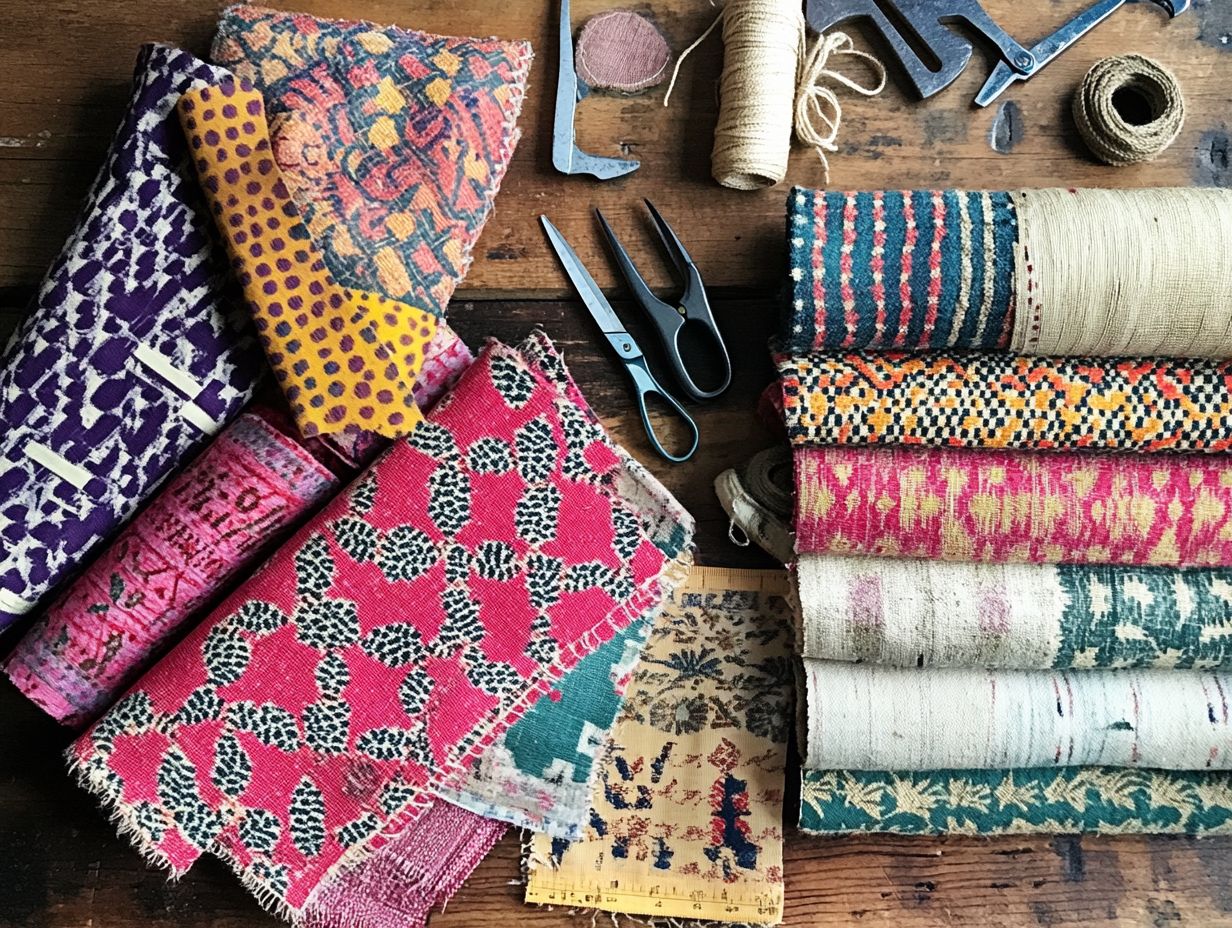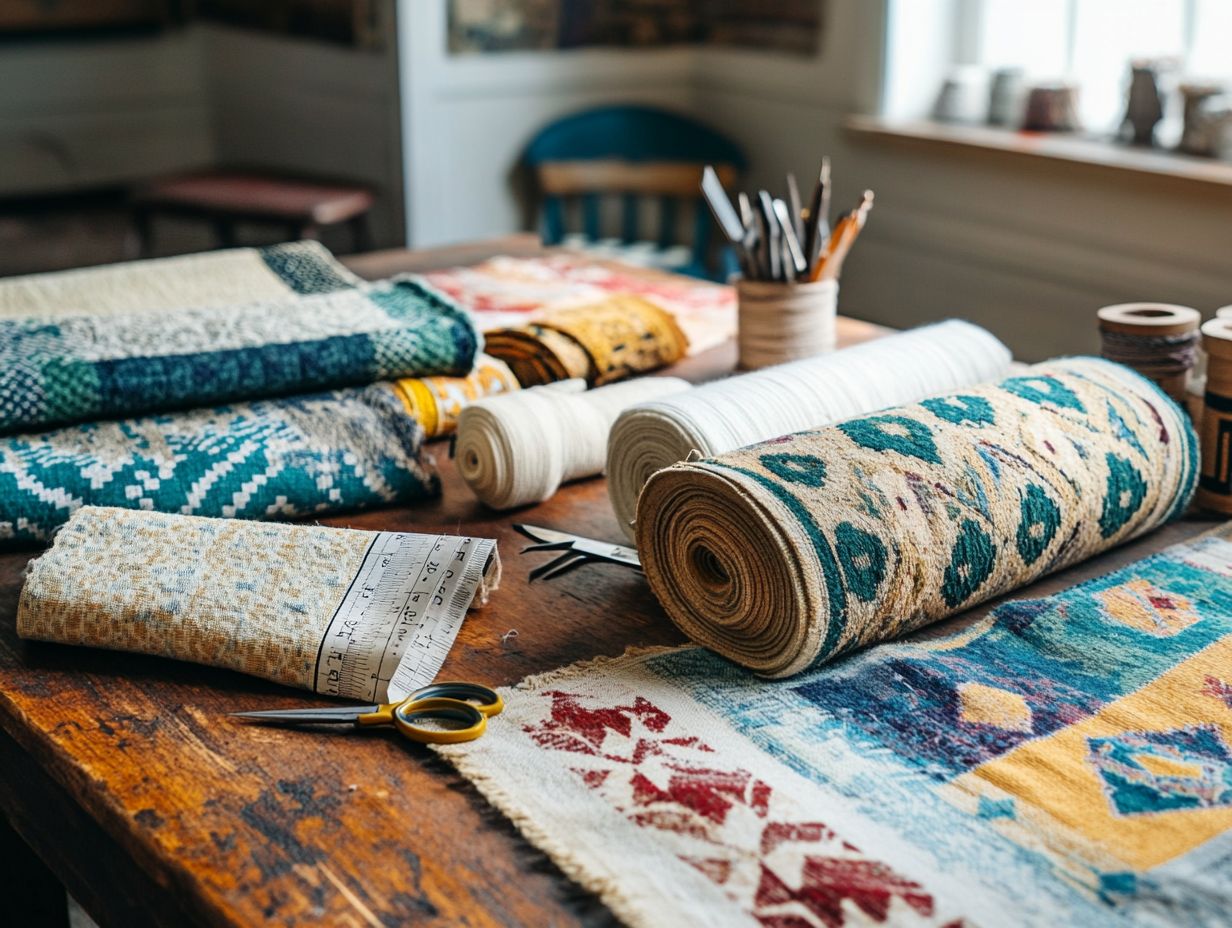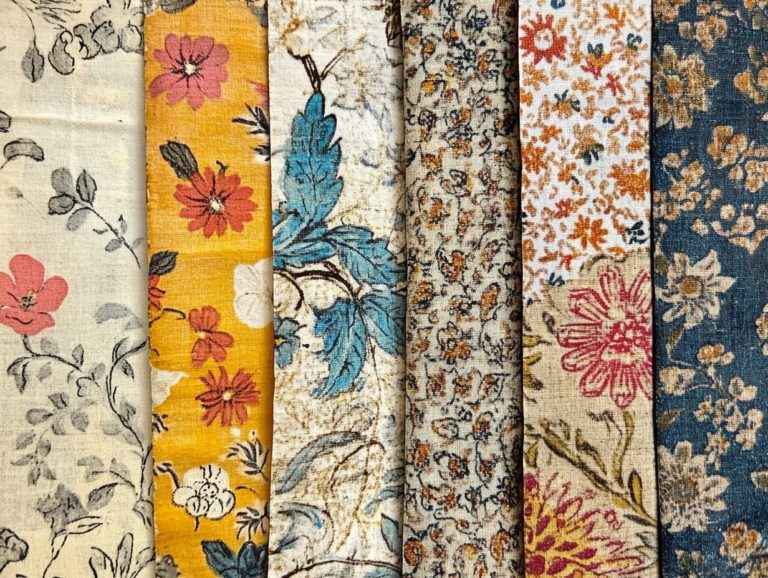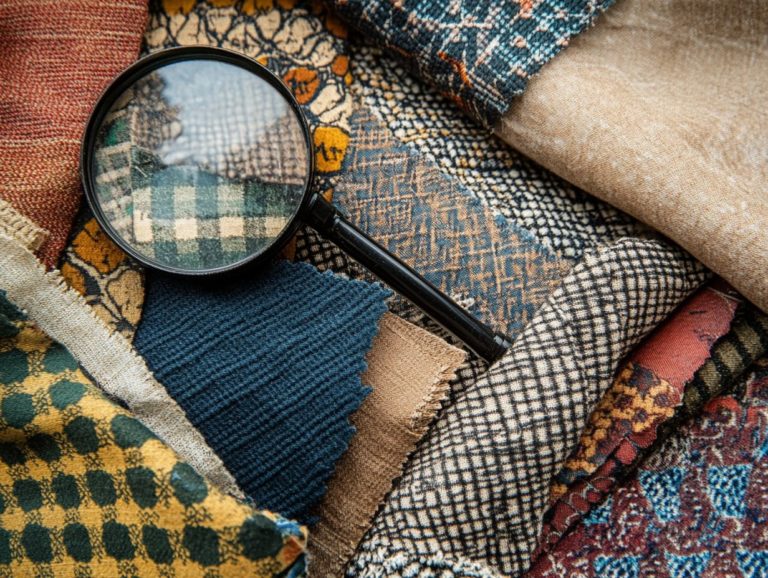Sourcing Vintage Textiles for DIY Projects
If you re seeking to infuse your DIY projects with a touch of charm and history, vintage textiles could be just what you need. These distinctive fabrics not only elevate the aesthetics of your creations but also champion sustainability by breathing new life into old materials.
This article delves into the myriad benefits of using vintage textiles. It will guide you on where to discover them in thrift stores and online marketplaces, along with tips for selecting quality pieces.
It also offers creative project ideas and essential care tips to ensure your vintage treasures remain stunning for years to come.
Prepare to transform your DIY endeavors with the rich textures and captivating stories that vintage textiles provide!
Contents
- Key Takeaways:
- Why Vintage Textiles Will Transform Your DIY Projects!
- Where to Find Vintage Textiles
- How to Choose Quality Vintage Textiles
- Tips for Cleaning and Caring for Vintage Textiles
- Ideas for DIY Projects with Vintage Textiles
- Frequently Asked Questions
- What counts as vintage textiles?
- Where can I find vintage textiles for my DIY projects?
- What should I look for when sourcing vintage textiles sustainably at Haines Collection, including fabric donations?
- How can I incorporate vintage textiles into my DIY projects?
- Are there any special care instructions for fabric care for vintage textiles?
- Can I source vintage textiles sustainably?
Key Takeaways:

- Vintage textiles offer a unique aesthetic and help reduce environmental impact in DIY projects.
- Thrift stores, flea markets, online marketplaces, and social media are great places to find quality vintage textiles.
- When choosing vintage textiles, pay attention to fabric types and condition to ensure the best results in your DIY projects.
What are Vintage Textiles?
Vintage textiles encompass a rich tapestry of fabrics that carry historical significance. They are distinguished by their unique patterns, textures, and unmatched quality. You ll be amazed by the charm of materials that are at least 20 years old, including antique textiles and one-of-a-kind fabrics sourced from thrift shops or fabric stores.
The world of vintage textiles includes reclaimed, deadstock (unsold fabrics that have never been used), and even destash fabric. This makes them important for eco-friendly projects. For those looking to explore further, check out the best vintage fabric resources online.
The allure of vintage textiles goes beyond mere looks; they act as a tangible connection to the past, showcasing the craftsmanship and styles of bygone eras. As you explore various types, such as silks, linens, and cottons, you ll find that each fabric tells its own story and exudes a distinct charm.
These materials are increasingly cherished for their sustainability. By embracing vintage textiles, you can repurpose and reuse what might otherwise find its way to a landfill, contributing to a more sustainable future.
This union of creativity and environmental consciousness in your sewing projects speaks volumes about your commitment to artistry and the planet.
Why Vintage Textiles Will Transform Your DIY Projects!
Utilizing vintage textiles in your DIY projects presents a wealth of advantages that extend beyond mere personal creativity. It s a powerful step toward promoting sustainability and minimizing textile waste.
Opting for vintage fabrics, including reclaimed and deadstock options, positions you as a champion of eco-friendly choices. These materials contribute to fabric recycling and allow you to craft projects that pay homage to both the past and the environment.
Vintage textiles also bring unique aesthetics to your creations qualities that modern materials simply can’t replicate.
Unique Aesthetics and Environmental Impact
The unique aesthetics of vintage textiles elevate the visual appeal of your sewing projects while carrying an environmental significance that aligns perfectly with eco-friendly crafting practices. These fabrics, rich in history and character, enable you to express your individuality while supporting a sustainable textile economy that actively combats waste.
By repurposing these exquisite materials, you reduce reliance on new fabrics, championing sustainable options that uphold the principles of environmental wellness.
Engaging in textile recycling not only decreases the volume of discarded materials but also sparks a new wave of creativity, leading to designs that are both stylish and ecologically responsible.
This harmonious blend of aesthetics and sustainability makes vintage textiles an essential choice for anyone dedicated to eco-conscious living.
Don t wait start exploring vintage textiles today to elevate your DIY projects! Share your own projects or experiences with vintage textiles to enhance community engagement.
Where to Find Vintage Textiles
Embarking on the quest for vintage textiles can truly be an exhilarating experience. Get ready to uncover amazing treasures in myriad locations, from charming thrift stores to bustling flea markets, specialized fabric shops, and online marketplaces.
Each of these venues presents a distinctive array of fabrics, ranging from leftover fabrics from individual sellers to carefully curated collections from reputable fabric markets. This variety makes it effortless for sewing enthusiasts like you to find high-quality materials that perfectly suit your projects, especially when considering the impact of vintage textiles on eco-friendly design.
Thrift Stores and Flea Markets

Thrift stores and flea markets are your personal treasure troves. They are brimming with vintage fabrics that can ignite your creativity for sewing projects. These spots offer a variety of unique fabrics. From reclaimed materials to antique textiles, they are perfect for cost-effective and sustainable shopping.
When you re on the lookout for high-quality fabric, take a moment to examine items closely. Look for signs of wear that might impact durability. Checking the labels is equally important; they reveal the fabric’s material and origin, providing valuable insights into its overall quality. Each unique fabric has a story to tell whether through intricate patterns or historical significance and can easily become a focal point in your creations.
Frequent visits can lead to delightful surprises, as the inventory is constantly changing. Approach these shops with an open mind and a clear vision to uncover truly exceptional fabric finds that can elevate any project to new heights. Don t miss out on these one-of-a-kind fabrics!
Online Marketplaces and Social Media
Online marketplaces and social media platforms have transformed the way you shop for vintage fabrics. It s now effortless to source unique materials from around the globe.
This shift has opened the doors to rare finds and cultivated a vibrant community of creators who thrive on shared creativity. As you explore platforms like Etsy, you re diving into a treasure trove of inspiration, with each piece whispering its own story. Social media channels allow fabric enthusiasts like you to connect, share your discoveries, and collaborate on projects, creating a supportive environment that champions sustainable crafting practices.
In these interactive spaces, sourcing vintage textiles becomes more than just a hunt for fabric; it s an opportunity to build relationships and find a sense of belonging within a shared passion.
How to Choose Quality Vintage Textiles
Choosing quality vintage textiles requires a keen understanding of different fabric types and a careful assessment of their condition to ensure they align with your sewing projects.
Consider factors like the fabric’s texture, durability, and aesthetic appeal. These elements are essential in determining whether a piece of vintage fabric is truly suitable for your crafting endeavors. You might also explore upcycling vintage finds for creative DIY ideas that can enhance your projects.
Fabric Types and Condition
Understanding the different fabric types and their conditions is essential when selecting quality vintage textiles for your projects. Fabrics like cotton, silk, and wool each possess unique characteristics that impact both usability and aesthetic appeal. By examining the fabric’s condition for signs of wear or degradation, you can ensure that you’re making a wise investment in your sewing supplies.
Consider linen, renowned for its durability and breathability, which carries a historic charm. Velvet, on the other hand, exemplifies luxury and demands careful handling. When evaluating these vintage textiles, it’s crucial to check for fading, fraying, or stains that could compromise their integrity. Additionally, exploring the timeless appeal of vintage textiles can provide valuable insights. Pay attention to any repair patches or discoloration, as these factors can significantly influence both the fabric’s longevity and its overall value.
A discerning eye will not only enhance your appreciation of the unique textures and patterns but also guide you in selecting pieces that will endure in your crafting endeavors.
Tips for Cleaning and Caring for Vintage Textiles
Cleaning and caring for vintage textiles necessitates a discerning approach to preserve their distinctive qualities and enhance their longevity.
Utilizing gentle cleaning methods and employing appropriate storage techniques is essential for maintaining the integrity of these exquisite fabrics, ensuring they remain both beautiful and functional for generations to come.
Gentle Cleaning Methods and Storage Techniques

Gentle cleaning methods, like hand washing or using mild detergents, are essential for preserving the quality of vintage textiles. Proper storage techniques, such as keeping them in breathable fabric bags, can significantly extend their life.
By adopting these practices, you ensure that the beauty and uniqueness of these fabrics are maintained. This allows you to enjoy them in future sewing projects.
Avoiding harsh chemicals and excessive scrubbing is crucial. These can lead to fading or irreversible damage.
In terms of storage, rolling your textiles and utilizing reclaimed fabric instead of folding them can prevent creases. Placing them in a cool, dark environment minimizes exposure to light and humidity, both notorious for deteriorating delicate fibers.
Using acid-free tissue paper and fabric scraps as padding between layers is another effective technique that safeguards fine details and prevents snagging. With careful attention to fabric care and eco-friendly crafting, you can ensure your treasured vintage pieces remain vibrant and intact, ready to inspire your next creative endeavor.
Ideas for DIY Projects with Vintage Textiles
Vintage textiles open the door to a wealth of DIY projects, including crafting supplies. They present endless opportunities for creative reuse and upcycling in your sewing journey.
Imagine transforming unique fabrics into chic accessories! You can create stunning home decor pieces or use thrifted items. The possibilities are as varied as the textiles you choose, allowing you to showcase your individuality while embracing sustainable fabrics.
Creative and Functional Uses
Vintage textiles offer a delightful blend of creativity and functionality, making them perfect for a myriad of sewing projects involving fabric buying and fabric crafts. Imagine sewing a unique tote bag, crafting a patchwork quilt, or designing decorative home textiles. These fabrics elevate your artistry while bringing practical charm to your crafting endeavors.
With their rich history and diverse patterns, you can transform these fabrics into striking pillows that infuse character into any room. Explore the beauty of handwoven vintage fabrics and use them in apparel design with deadstock fabric material that would otherwise go to waste to create one-of-a-kind garments that narrate a story.
If you’re eager to immerse yourself in the world of fabric crafts, incorporating vintage pieces can ignite your creativity and champion sustainable practices. For inspiration, check out where to find authentic vintage fabrics. Consider making table runners or even vintage notions that showcase vibrant floral prints. You can also use remnants to embellish contemporary items like phone cases.
Each project not only honors the unique aesthetic of vintage textiles from brands like Blackbird Fabrics and Revival Fabrics, but also unveils the endless possibilities that await in the realm of DIY crafting.
Frequently Asked Questions
What counts as vintage textiles?
Vintage textiles are fabrics or materials that are at least 20-30 years old and have a unique and nostalgic quality. They can include items such as clothing, linens, drapery, and upholstery.
Where can I find vintage textiles for my DIY projects?

You can find vintage textiles at thrift stores, fabric markets, flea markets, antique shops, and online marketplaces such as Etsy or eBay. You can also ask family and friends if they have any old textiles they no longer need.
What should I look for when sourcing vintage textiles sustainably at Haines Collection, including fabric donations?
When sourcing vintage textiles, focus on quality materials. Look for sustainable textiles that are in good condition, free of stains, holes, or tears.
Consider the size and pattern of the fabric to ensure it fits your project.
How can I incorporate vintage textiles into my DIY projects?
You can creatively use vintage textiles in a variety of ways. Repurpose old clothing into new garments, use vintage linens for home decor, or add vintage fabric to quilts and sewing projects.
Are there any special care instructions for fabric care for vintage textiles?
Yes, vintage textiles need special care to keep them in great condition. Always follow the care instructions on the fabric label and handle them gently when washing or storing.
Can I source vintage textiles sustainably?
Absolutely! You can source vintage textiles sustainably by shopping at thrift stores or repurposing old items. This approach reduces waste and gives new life to old materials.
Supporting small businesses that specialize in vintage textiles is another great option!






